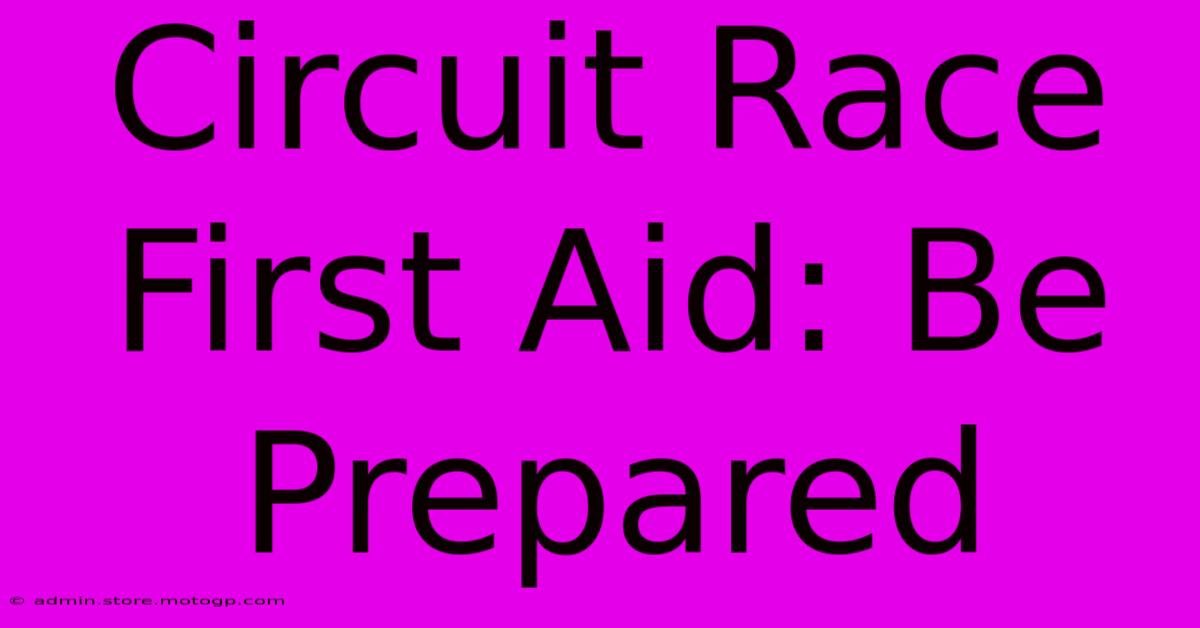Circuit Race First Aid: Be Prepared

Table of Contents
Circuit Race First Aid: Be Prepared
Circuit racing, with its high speeds and close competition, inherently carries a risk of injury. Being prepared for accidents is crucial, not just for the racer's safety but also for the smooth running of the event. This article will guide you through essential first aid knowledge and equipment for circuit racing. Whether you're a seasoned racer or a newcomer, understanding these elements is paramount.
Essential First Aid Kit for Circuit Racing
A comprehensive first aid kit is the cornerstone of safety. Your kit should go beyond basic supplies and cater specifically to the injuries common in motorsport. Don't skimp – proper equipment can mean the difference between a minor setback and a major emergency.
Must-Have Items:
- Sterile Gauze Pads: Various sizes for controlling bleeding.
- Adhesive Bandages: Assortment of sizes for minor wounds.
- Elastic Bandages: For supporting injuries and controlling swelling.
- Triangular Bandages: Versatile for slings, splinting, and pressure points.
- Trauma Shears: For cutting through clothing quickly and efficiently.
- CPR Mask: Essential for providing mouth-to-mouth resuscitation safely.
- Instant Cold Compress: To reduce swelling and pain from bruises and sprains.
- Antiseptic Wipes: For cleaning wounds and preventing infection.
- Pain Relievers: Ibuprofen or other appropriate pain medications (check regulations).
- Gloves: Multiple pairs of disposable nitrile gloves for hygiene.
- Eye Wash Solution: For flushing out debris or chemicals from the eyes.
- Blankets: For keeping injured individuals warm.
- Emergency Whistle: To attract attention in case of emergencies.
Consider These Additions:
- Tourniquet: For severe bleeding, though proper training is crucial for use.
- SAM Splint: A versatile splinting device for stabilizing fractures.
- Cervical Collar: For suspected neck injuries (requires proper training to apply).
- Emergency Medical Information Form: To record vital information of injured racers.
Beyond the Kit: First Aid Training and Knowledge
Having a well-stocked kit is only half the battle. Knowing how to use the equipment effectively is equally important. Proper first aid training is essential for anyone involved in circuit racing, from marshals to team members.
Crucial Skills to Learn:
- CPR and First Aid Certification: These are fundamental and should be regularly updated.
- Bleeding Control: Understanding how to apply direct pressure, elevation, and tourniquets (if trained).
- Immobilization Techniques: Knowing how to properly splint injuries to prevent further damage.
- Shock Management: Recognizing and treating the symptoms of shock.
- Head and Neck Injuries: Understanding how to handle potential spinal injuries and the importance of stabilization.
- Assessment of Injuries: Learning how to prioritize injuries and providing care in a systematic way.
Safety Protocols at the Track
A well-prepared first aid kit and trained personnel are only part of the equation. Effective safety protocols at the circuit are vital for minimizing risks and maximizing response times in case of incidents.
Important Considerations:
- Clearly Marked First Aid Stations: Easily accessible locations with readily available equipment.
- Designated Medical Personnel: Trained medical professionals on-site throughout the race.
- Effective Communication Systems: Reliable communication between marshals, officials, and emergency services.
- Pre-Race Safety Briefing: A thorough briefing on safety procedures and emergency protocols for all participants.
- Emergency Response Plan: A detailed plan outlining procedures for handling accidents and evacuations.
Conclusion: Preparedness Saves Lives
Circuit racing demands a proactive approach to safety. By equipping yourself with a comprehensive first aid kit, undergoing appropriate training, and implementing strong safety protocols, you can significantly reduce the risks associated with this exhilarating sport. Remember, being prepared is not just about responding to emergencies; it's about preventing them in the first place. Prioritize safety and ensure a smooth and enjoyable experience for everyone involved.

Thank you for visiting our website wich cover about Circuit Race First Aid: Be Prepared. We hope the information provided has been useful to you. Feel free to contact us if you have any questions or need further assistance. See you next time and dont miss to bookmark.
Featured Posts
-
Moto 2 Bike Specs The Science Behind The Speed
Feb 19, 2025
-
Analyzing The Champions What Makes A Moto Gp Winner
Feb 19, 2025
-
Cota Hospitality Your Gateway To Exclusive Race Access
Feb 19, 2025
-
Moto2 Specs The Future Of Racing
Feb 19, 2025
-
The Price Of Being A Moto Gp Champion
Feb 19, 2025
